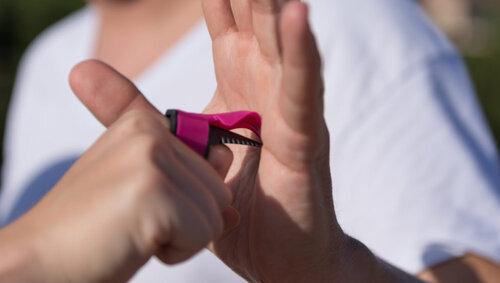
(Note: Some of the links in this post are affiliate links, and we will be compensated when you make a purchase by clicking through our links at no additional cost to you.)
As a runner, you may already know how important it is to have strong glutes, quadriceps, hamstrings, hip flexors, and calf muscles. However, one vital muscle group is often overlooked: the pelvic floor. For all postnatal persons, in particular, it’s crucial to ensure that the pelvic floor muscles are functioning optimally.
Research shows that almost 50% of women in the U.S. experience urinary incontinence, with over half of them being under 50 years old. Pelvic floor dysfunction can significantly impact a woman’s life, eroding her confidence in her body, affecting her exercise choices, and impacting her relationships, sex life, and even her career.
Returning to running postpartum can be a daunting task, and historically, healthcare providers have lacked guidelines to assist patients in their postpartum journey. However, in March 2019, three physiotherapists in the UK published the first set of guidelines for returning to running postpartum. These guidelines link pelvic health signs/symptoms to the musculoskeletal and mechanical components of running, using currently available pelvic health research outcomes to create individualized running programming for postpartum clients.
It’s crucial to ease back into running postpartum, whether the goal is a casual jog or a competitive marathon. After giving birth, the abdominal wall and pelvic floor tissues are stretched, weak, and may be injured. High impact activities, such as running, can dramatically increase intra-abdominal pressure and muscular demand on the pelvic floor. When you run, the ground reaction force can be as much as 2.5 times your body weight, which mostly transfers to the pelvic floor. A well-functioning pelvic floor can activate and contract just before your foot hits the ground to match this force. An inappropriate return to high impact sports can contribute to pelvic organ prolapse, urinary incontinence, sexual dysfunction, and pain conditions.
Regardless of prior physical condition or type of birth, the first step to returning to running postpartum is to allow time for your tissues to heal with a period of relative rest. While having the “all clear” at your 6-week checkup means there is no sign of a condition or issue requiring medical intervention by the physician, it does not mean that your tissues are done healing or that they are ready for high impact. The first three months postpartum are a time for rest, breathwork, walking, attention to body mechanics and posture, and low impact exercises rebuilding your connection to your core.

Here Are Some Key Research Takeaways For Returning To Running After Having A Baby:
1) Pelvic Health Evaluation:
All individuals who have recently given birth can benefit from receiving a personalized pelvic health evaluation from a pelvic floor therapist within the first six weeks. This can help prevent and manage pelvic organ prolapse, urinary incontinence, and sexual dysfunction. If that’s not possible, the MUTU System can help women:
- build their a solid and strong foundation to enable them to run
- address symptoms they get when they run
- run injury-free
- heal their diastasis recti so they can run again
- strengthen their pelvic floor to prevent leaking whey they run
- gets stronger and functional so they can get faster and better at running
2) Timing For Return To Running Postpartum:
It is recommended to wait a minimum of three months before resuming running after giving birth. Gradually returning to running is acceptable between 3-6 months postpartum as long as there are no signs or symptoms of pelvic floor dysfunction.
3) Steps For Returning To Running Postpartum:
It is important to reintroduce running gradually by starting with walking and running intervals. Increase volume before intensity by slowly increasing distance and frequency before adding in speed and terrain challenges. Don’t forget to prioritize cross-training recovery strategies and getting adequate sleep for optimal success.
Red Flags To Pay Attention To:
Pelvic floor dysfunction affects a large number of women and can manifest in various ways. If you experience any of the following symptoms, it is essential to pay attention and seek professional help:
- Leakage of urine or stool
- Difficulty pooping
- Painful intercourse
- Pelvic and/or low back pain
- Heaviness, pressure, or bulging in the low pelvis
Additionally, there are several risk factors that can contribute to pelvic floor dysfunction, including:
- Breastfeeding
- Obesity
- Scarring from cesarean or perineal tears
- Pre-existing pelvic floor issues
- Pre-existing hyper-mobility condition
- Postpartum depression
The pelvic floor is essential for basic daily activities such as coughing, sneezing, laughing, lifting, walking, going to the toilet, and sex. Pregnancy, childbirth, and other lifestyle or occupation factors can negatively impact the pelvic floor, making it vital to take steps to maintain and strengthen this muscle group. It is recommended that you work with a professional pelvic floor physical therapist who can help you develop a customized plan to meet your postpartum running goals. If that’s not possible, then be sure to check out the evidence based MUTU System. Understanding how your body is healing after childbirth and tailoring your exercise routine accordingly can make a significant difference. By balancing risk and reward, you can work towards your goals safely and effectively.
Yoga is another popular way to increase pelvic floor strength, which teaches the correct muscle recruitment patterns and focuses on strengthening the deepest muscles that help us perform better across all aspects of movement and physical activity.
>>> Read more: Looking for a great yoga program? Be sure to check out the Yoga Burn Challenge. Click here.
>>> Download the FREE Discover the 6 Surprising Habits Contributing To Your Mom Pooch Guide
>>> Download the FREE How To Recognize Pelvic Floor Tightness: 7 Common Signs & Symptoms Guide






